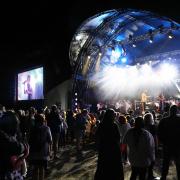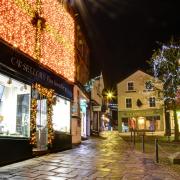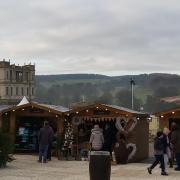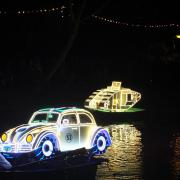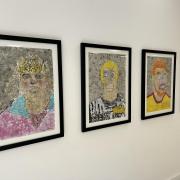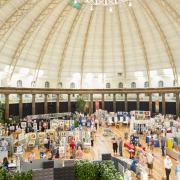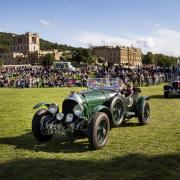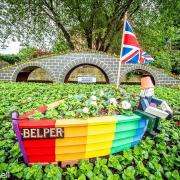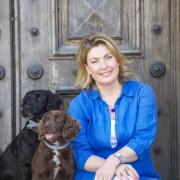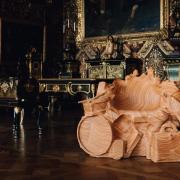Simon Burch tells the fascinating story of The Knowle near Hazelwood

Around 100 years ago, with her husband away serving his country and alone in her grand country home on a Derbyshire hillside, Edith M Hull sat down to write. What emerged from her work was a book that would go on to sell millions of copies, bought by readers hooked on Edith’s tale of a young English lady who travels to Arabia, only to be kidnapped and ravished by a cruel sheik.
The book was, no surprise, The Sheik, which was labelled ‘poisonously salacious’ when it was published in 1919 and was later made into a film starring Rudolph Valentino. The house, meanwhile, was The Knowle, which is situated in the rural idyll of Nether Lane, Hazelwood, and became Edith’s home in the early 1900s.
It is exactly 70 years since Edith’s death in 1947 but also, coincidentally, The Knowle’s 70th anniversary under the ownership of global chemical company Lubrizol, which now uses it as its UK headquarters.
Unsurprisingly, the house plays a very different role to that which it did in Edith’s time but if her ghost was to drift past the old cedar tree planted outside her former home and approach the entrance, it would notice that very little has changed.

The outer walls are the same as they were when it was built in 1848, while the front rooms and staircase are unchanged too. Behind the scenes, though, there have been many developments – not least the fact that the house is now surrounded by a series of buildings which have sprung up over the years to support Lubrizol’s growing Hazelwood operation.
To answer the question about how Edith’s old address became Lubrizol’s UK home, you have to speak to former Lubrizol employee Colin Jordan, who has traced The Knowle’s story back to when it was built by a Miss Frances Roe.
Details are sketchy, but it appears that the Knowle was at the time one of the grandest country homes in the county, with gardens designed by former Chatsworth gardener Joseph Mooney, who had worked under Sir Joseph Paxton.
Frances married William Winstanley Hull, a Chancery barrister, in 1850, but died just a few years later, leaving the estate to her husband. He remarried and, according to the Census records, by 1871 the family had expanded with the addition of three daughters and a son called Percy. Two years later, William died too, and the family moved to Holmeside up the road.

By 1881, only servants were living in The Knowle and in 1891 it was occupied by a man described as ‘living on his own measures’. By 1901 it was home to a clergyman.
‘There were a lot of changes at that time and we know that in 1906 the Eadie family were living there,’ Colin says. ‘They provided photographic evidence of what the house looked like at the time, but by the time of the next Census of 1911 it appears that they’d moved out too and it was occupied by the gardener and caretaker.’
But new owners, ones who would provide some stability, were waiting in the wings. By 1890, Percy Hull, who had been mentioned in the 1871 Census, was working as a civil engineer in London, where he met and married Hampstead-born Edith Henderson, the daughter of a ship-owner called James Henderson.
Percy, who records show also bred pigs, returned to live at The Knowle some time in the early 1900s, leaving Edith alone to write when he did his duty abroad during the First World War.

Edith had travelled widely when she was younger and this gave her plenty of exotic locations for her own brand of romantic fiction. Despite content which has now fallen out of fashion, the book was the Fifty Shades of Grey of its time and was made into a film starring Rudolph Valentino.
The film was premiered at the Empire Cinema in Becketwell Lane, Derby, but, reportedly upset at the derisory amount she was paid for the rights, Edith did not attend.
‘I have read The Sheik, but I didn’t last very long with it,’ said Colin. ‘It’s not really my thing and I didn’t think it was a very good story but there’s no doubting that it became extremely popular and was a real bodice-ripper in its day.’
Edith went on to write six more books, including the popular The Sons of the Sheik, and died aged 66 in 1947.
She had already moved out of the Knowle by then and was living up the road in Holmeside, with her old home now in a dilapidated state.
It was soon rescued, albeit by a very unexpected party, a company called Anglamol, which was a three-way venture between the US-owned Lubrizol Corporation, a UK phosphorous manufacturer called Allbright & Wilson and lubricants firm Dalton & Co, which was based just a few miles away in Belper.
It is likely that it was the involvement of Dalton & Co – which went on to become Silkolene – that brought Lubrizol to Derbyshire. Previously, Lubrizol had supplied all of the additives used in UK engines but after the Second World War ended, the British Ministry of Supply realised that this could not continue and so brought the three companies together to establish a domestic manufacturing facility.
Anglamol’s general manager, Alfred Towle, was asked to find a suitable location for the new company and looked at 54 Derbyshire properties during his search. A gifted engineer, he had previously worked at Rolls-Royce in Derby, fitting in his work as a mechanical test engineer amongst his stated hobbies of motor cruising, photography and table tennis.
He decided that the faded glory of The Knowle was an ideal and affordable location and work soon began to make the house fit for purpose.
‘It’s not known how or why Alfred got the new position with Anglamol, but it’s clear that he put his local knowledge to good use after working at Rolls-Royce and plenty of the employees who started working there were ex-Rolls-Royce too,’ says Colin.
‘The house was not in a good condition and needed a tremendous amount of work to convert it into a test and research facility. It’s not like now, when you just go along to the builder’s merchants and pick up materials. This was after the war, when materials like steel were scarce and people still had the make do and mend attitude.
‘As far as they were concerned, The Knowle was available, it was in the right location and, with a bit of work – although it can’t have been easy – they recognised it had the capacity to be turned into somewhere they could establish the new business.’
Records show that the house and an additional 15.5 acres cost the company £9,000, which was paid to its by-then owner, Edgar Goodall, with a further £5,000 set aside for conversion.
And what a conversion process it was. The house started with 22 individual rooms, but upstairs in the servants quarters all the walls were dismantled to create one big room to house the chemical laboratory.
Downstairs, although the front room and staircase were retained, the former brewery, bakery and laundry rooms were converted into a test house, with all partitions removed and cast-iron bed plates installed into the floor to carry equipment to the test beds.
The old library, meanwhile, was converted into the engine fitting shop, with 1,000 gallon tanks installed underground to store fuel. Until the test room was completed, engine testing took place in the coach house.
‘The house, though, changed very little at the front,’ Colin says. ‘The cedar tree was still there from the original gardens and I remember that there used to be a full-scale garden that used to supply vegetables to the kitchens.
‘The laboratory had only recently moved out of the house when I started working at the company,’ Colin says, ‘having transferred into a purpose-built facility in 1962. When I retired, the finance team were based in the former laboratory.’
By this time the site had been increased by a further 62 acres and the company had officially been renamed Lubrizol, the Americans having bought out the other two firms in 1956.
Over the years, a new restaurant block and a number of other buildings were also added as the site continued to grow. Gradually, the site changed from playing a supportive role in Lubrizol’s additives product development to taking the leading role and it is now responsible for the development of many new products and concepts in its own right, working alongside the world’s leading car manufacturers and global fuel companies to create and test the additives of the future.
The number of staff working on the site has also increased, from seven or eight in 1947 to more than 300 today – although Colin is no longer there, having retired in 2009.
He said: ‘The company changed a lot over the time I was there. There were 80 employees there when I started and there were 250 when I left.
‘I was proud to work there, it was a good company with an excellent reputation and from what I understand it still is.’
Although the company has expanded its site rapidly, it does so while respecting its rural location. It works closely with Derbyshire Wildlife Trust to protect and support the animals and birds which also call The Knowle home, from the woodpeckers in its woods to the hares which can be seen criss-crossing the lawns in the early morning.
Its latest plan, to build a new £8m training centre, will also be developed with the environment in mind, with a host of eco-friendly features such as a living roof and a geo-thermal water heating system, and partly constructed underground by excavating into the hillside.
It will open a new chapter in the story of Lubrizol Hazelwood, but the company remains committed to respecting and preserving the place where it all began – the house where Edith wrote about her heroine’s adventures in the sand and heat of faraway Arabia.






